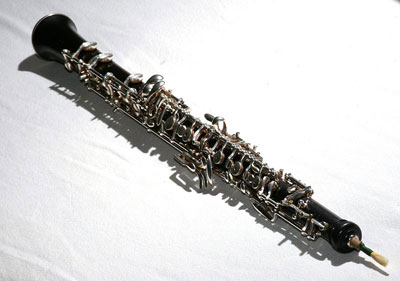Oboe & English Horn
The oboe as we know it today was developed in the 1860s. There were several instruments dating back to antiquity that could be considered ancestors of the oboe.
When the reed vibrates the sound waves continue down the length of the oboe until there is an open hole. At this point the sound wave exits the instrument. The further the sound wave travels down the instrument, the lower the sound.
The modern oboe is made of wood. It consists of four parts including the reed, the upper joint, the lower joint, and a small bell. The fingers are used to cover holes or depress pads that cover the holes.
The English horn is not English nor is it similar to any horn. However, it produces a unique expressive sound in the lower register that has appealed to composers for some time. The English horn is longer than the oboe. The oboe is 1 foot 11.5 inches long and the English horn is 2 feet 7.5 inches long. This additional length makes it possible for the English horn to play lower notes than the oboe. Played in the upper register, the English horn sounds thinner and more like an oboe.
Study the image provided and listen to the sound samples of the oboe to gain an understanding of this instrument.
![]() Listen to a sample of the oboe:
Listen to a sample of the oboe:
